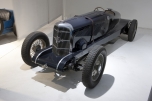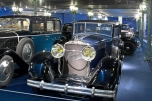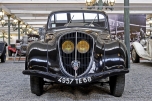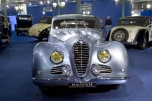Cars from 1920 to 1950 - The golden age of the car
Amilcar Type CO
1926
Code 1301
Body style: GP two-seat
This little beauty is an Amilcar from 1926. The make took its name from two French industrialists Lamy and Akar from Saint-Denis near Paris. Along with many other small manufacturers, the make first made its name with cyclecars (lightweight vehicles of under 350 kg, with engines smaller than 1100 cc), that were subject to lower levels of tax. In 1921, engineer Edmond Moyet, designer of the famous Citroën 5 CV, was commissioned to create a lightweight vehicle with the sturdy qualities of a standard series-produced automobile. His work led to the CC model with its 1000 cc engine and the CGSS (1100 cc).
The models sold well, thanks to their solid, reliable design. Racing drivers wanting to compete in motor races at fairly low cost saw Amilcar as their opportunity. The Type CO was the next development, on the back of these successes. Its six-cylinder engine was only 1100 cc, but produced 83 horsepower, with two overhead camshafts and a supercharger. From the very start of its career, this lightweight (500 kg) racer was hitting speeds of close to 200 kph (125 mph), and gave its main rival, the Salmson 1100 a real run for its money. The engine was further developed, to create a competition version, reaching 107 hp and engine speeds off 7000 rpm. Both versions were very successful on either side of the Channel. André Morel made the record books in unforgettable fashion in 1927 with a stunning performance in Arpajon, raising the bar to 207 kph (129 mph) for the 1100 cc category. Driver Moriceau then entered the Indianapolis 500 in 1929, inspired by Morel’s performance, but the little 1100 cc model predictably faced stiff opposition. The vehicle on display in the Cité de l’Automobile was used by Maurice Trintignant for his first win at the Avignon Grand Prix in 1947, a full 20 years after the car first came out.



































